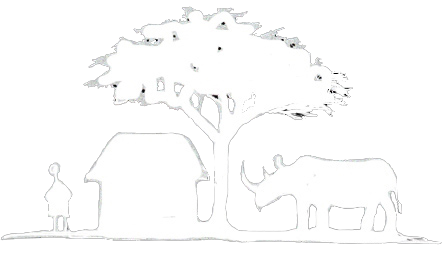Arriving at Kachiuru
April 1, 2017 Our first visit to Kachiuru village was in January of 2004 during John’s and my second visit to Kenya. With our guide, we had driven through Shaba National Park in Central Kenya earlier in the day and then had gone on to Magado Crater. A tortuous walk down the steep, rocky slopes of this extinct volcano into the crater takes one to a shallow lake at the bottom where people from the area bring their animals for water and miners, who live in small caves on the edge of the crater, mine salt. Although the water is saline, people from Kachiuru use donkeys to carry jerry cans of water from Magado to the village, several kilometers away, for their domestic use. The environment is harsh- hot, dusty and windy and after hiking into the crater and back up, we stopped at Kachiuru, the only village for miles around, to get something to drink.
The children at Kachiuru rarely see mzungus (white people) and gathered around to watch as we drank our sodas. When we asked them why they weren’t in school, they showed us a slanting building that looked like a strong wind could easily blow it over. Most of the roof was missing and we could see a broken chalkboard inside through the holes in the walls. Before we left the village, we had promised to help the community build a nursery school. That promise was the beginning of a 13 year (so far!) relationship with the Kachiuru community.
Medical officers meet at Kachiuru in January to plan for the dispensary opening
With many basic needs unmet there, the priority for the community was to have a school. In 2005, FKSW provided funds for materials and labor for a nursery school and in January, we brought some friends from Oregon to help the community get the project started. Today, 250 students in grades 1-8 attend classes in the wooden school building that was constructed over the next several years. The government provides 6 teachers and the community pays salary for 2. The residents have built a separate nursery school building and with each family contributing one board, a staff room and Head Teacher’s office.
Since 2005, FKSW and NECOFA have supported many additional activities at Kachiuru. (These are listed in the Kachiuru section on the Projects page.)
Residents line up to see the doctors at a medical camp in 2014
The contractor and the painter finishing up the job
In 2013 and 2014, a Rotary grant provided funding for medical camps at Kachiuru. For many residents, this was the first time they had ever seen a doctor or received health services of any kind. Over 250 people came to each camp, and as a result of the experience, the community asked for help to build a medical dispensary. With the nearest hospital hours away, they wished to have a local facility that could proved regular services as well as immediate attention for emergencies. Last year, our wonderful donor, WideAwake.org, contributed $14, 000 in response to that request. When we visited Kachiuru in January, the building had been completed and the contractor was just finishing the painting. The building, with its yellow walls, bright green trim and shiny blue roof certainly stands out against the dusty, brown landscape!
Our team visiting in January 2017
Much credit goes to our partner, Samuel Muhunyu, for the success of this project. He worked with the community, architects, contractors and officers from the Kenya Ministry of Health to meet the requirements for the building to be a registered, government facility. The planning took several months. There are 4 rooms, one of which will be the temporary home for the full-time nurse, provided by the Kenya Ministry of Health. The medical officers visited the school in January and made a list of furnishings, medical equipment and supplies that needed to be in place before the dispensary can open and WideAwake.org has provided the funding to fulfill these requirements.
April 4, 2017...A note from Samuel today says, “We are already purchasing dispensary materials and equipment and have ordered fabrication for others. We wish to have everything ready by mid April. The medical team has confirmed that a nurse is ready to proceed to Kachiuru and will commence service delivery immediately we are ready.”
We are so grateful to Wide Awake for supporting the Kachiuru community in their efforts to bring health care to the residents there.
The toilet at the dispensary, almost finished.







